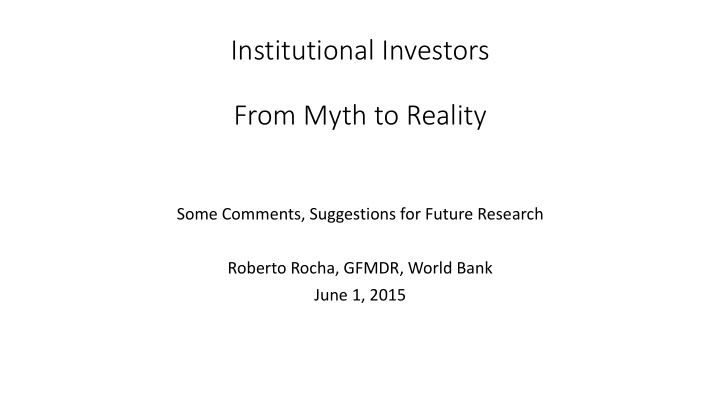



Institutional Investors From Myth to Reality Some Comments, Suggestions for Future Research Roberto Rocha, GFMDR, World Bank June 1, 2015
Research on Institutional Investors • Excellent, relevant, timely. Thank you! • More research is needed. Why? Several reasons: 1. Bank promoted multi-pillar reforms in 1990s, 2000s, second pillars a la Chile • About 25 emerging countries adopted. New systems not working well in most countries • Six serious casualties (Argentina, Hungary, Russia, Poland, Slovakia, Czech) • Many other countries downsizing their new mandatory systems. • What to do? New approach emerging: Try to salvage existing ones; new emphasis on voluntary, employer-based systems for new client requests 2. New post-2015 finance for development agenda endorsed by the Board • Emphasis on Long Term Finance, need for solid investor base. What to do? 3. Concerns with destabilizing role of Institutional investors in post crisis world • Especially investment funds, but some concerns with PFs, ICOs as well
Some Suggestions for Future Research • On the Lack of Institutional Investors • Several countries have developed instruments faster than institutional investors • Excessive reliance on banks, retail investors. Is there anything worse than that? • On Investment Funds • Results are extremely interesting, especially the problem of endogenous weights • Central issue in FSB discussions currently. But what are the policy implications? • Can investment funds become a reliable component of the investor base in EMDEs? • On Insurance Companies • Need to be careful in comparisons with Chile. Share of annuity providers in Chilean life sector higher than any other country in the world. • In other countries, asset composition is very related to structure of liabilities, which can be very different (unit-linked, with-profits, non-profit and non-linked) • Suggestion: More research with more granularity. In particular, examine the impact of the bancassurance model in expanding coverage. Examine life products, regulation and outcomes. This may become a major channel for pension coverage in the future.
Some Suggestions for Future Research • On Pension Funds • Twenty five emerging countries copied Chile, but other countries did not, especially higher income OECD countries, but also several MICs • More research needed, exploring differences in performance of employer-based systems versus open, individual, retail systems. Types of employer-based: • Occupational funds (with boards), both DB and DC • Contract-based funds (no boards), such as 401(k) plans • Employer-based pension funds are also being criticized in other countries for: • Herding • Failing to explore their long-term investment horizon, especially DC funds • Even for being pro-cyclical, although evidence here is very very mixed • However, when we compare the performance of employer-based funds with those of open, individual, retail, based funds they still look much better • Several countries have all these types, allowing for insightful comparisons • Need to understand better the reasons for differences in performance
Chile ilean-based systems: Portfolios remain dis isappointing in in many cases Share of government bonds (with short durations) and bank deposits is 70% of assets or higher in many countries Portfolio Composition (% of total assets) 100% 90% 80% 70% 60% 50% 40% 30% 20% 10% 0% Government Bonds Bank Deposits Corporate Bonds Domestic Equity Foreign Equity Other Avg. Gov. Bonds + Bank Deposits 5 Source: World Bank from National Sources, OECD global pensions database
UK Corporate DB Funds: De-risking from a very high initial share of equities in portfolios But how bad does it look?
Asset mix ix dif ifferences have been the prim imary ry reason for the under performance of U.S .S. . DC pla lans (Mik ike Heale le 2015) Su Sure, but th their ir perf rformance does s not t lo look so so bad by compari rison with ith most t countrie ies th that copie ied Ch Chile ile DB versus DC asset mix - U.S. 3 4 Asset class Asset mix Returns (Ranked by returns) DB DC DB DC Private Equity 4% n/a 12.6% n/a Real Assets 5% n/a 9.3% n/a Small Cap Stock 6% 7% 10.2% 8.4% Employer Stock 0% 21% n/a 8.6% Fixed Income 31% 10% 6.8% 6.7% Hedge Funds 2% n/a 7.7% n/a Stock U.S. Large Cap or Broad 26% 30% 6.8% 6.1% Stock Non U.S. or Global 23% 7% 6.7% 6.5% Stable Value/GICs n/a 17% n/a 4.9% Cash 2% 8% 2.9% 3.2% Total 100% 100% 7.9% 6.9% Number of observations 3,083 1,995 3. 17 years ending 2013. Equals arithmetic average of annual asset mix weights. 4. 17 years from 1997 to 2013. Returns are the geometric average of the annual averages for each asset class. Hedge funds were not treated as a separate asset class until 2000, so 60% stock, 40% bond returns were used as a proxy for 1997-1999. 7 n/a= insufficient data.
How about 401(k) plans? Again, not so bad by comparison
401(k) plans: increasing adoption of target dates
Australian case: Excellent candidate for further research Corporate and Industry Funds (Multi-employer) performing better than individual-retail funds
Why? Fewer choices, greater use of defaults
And the defaults seems to be doing a better job
Brazil: Another good candidate for research The very poor performance of open, individual, retail plans
Recommend
More recommend